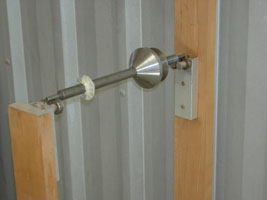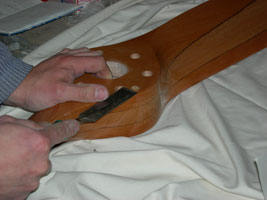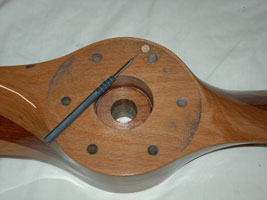Article 3:
How to Statically Balance a Wooden Aircraft Propeller
Have you ever seen an out of balance washing machine vibrate across the utility room floor? If so, you know that it’s important for machines that spin fast to be in balance. The same is true for propellers. Propellers can be out of balance from tip to tip and they can also be out of balance from one side of the prop hub to the other.
 |
Usually a new prop will be slightly out of balance. This is the tool we use to fix that. Mount the prop on a mandrel that clamps tightly in the center hole of the prop. |
 |
Now place the mandrel and the prop on a level rack that has two ball bearings on each end and gently spin it. |
 |
Now gently spin it around a couple of times just to make sure that it is in track. |
|
This lets you know that the mandrel is mounted correctly. It’s a good idea to do this a couple of times. This lets you be sure the mandrel is firmly mounted in the prop and that the mandrel is not creeping on the bearings. After you are sure that your prop is tracking correctly, spin it gently several times and see where the prop comes to a final stop. Do this several times to make sure you are making consistent measurements. If your prop stops in a random new position every time you spin it (and you are sure your technique is correct) then you have gotten lucky and your prop is already in balance. This would be unusual for a new prop. Probably your prop will stop in the same position every time. This is good because now you will have a reliable indication of the prop’s center of gravity. You will also know where to place your lead balance plug. |
|
 |
After the prop comes to a stop in a consistent position, the lead plug has to go directly above the center of the mandrel. |
|
But what would you do if the balance plug needed to go IN the prop bolt hole instead of just near the prop bolt hole? If the balance had worked out so that the plug needed to be on the hole, we could have inserted two smaller plugs one to the left and the other two the right of the bolt hole. You can’t put the balance weight hole between the prop bolt hole and the outer edge of the prop hub, because that would weaken the prop hub too much. Drill the hole for your lead balance weight. Then add an estimated weight to see how the balance works out. You can either trim it off or add more weight later if you need to. This will take a several minutes to re-test the balance until you are sure it’s right, but if you’re going faster, you’re doing something wrong. When you are sure the balance is correct, glue the lead weight in place with five minute epoxy. Put some glue in the hole first and then follow up with the lead weight. Push the weight down to the bottom of the hole with a piece of wood. |
|
 |
Now plug the top of the hole with a wooden plug, so put some epoxy on a wooden plug and then carefully fit it in place. If you want your friends to compliment you on your woodworking skills, make sure that you line up the wood grain of the plug with the wood grain of the prop. When the epoxy is dry, use a sharp chisel to trim the excess wood. |
 |
After the plug is trimmed flush, dab a couple of dabs of epoxy or varnish on the top of the plug to protect it from weathering. Here’s what the finished plug should look like. |
Now your prop is balanced, and you’re done. It’s easy.